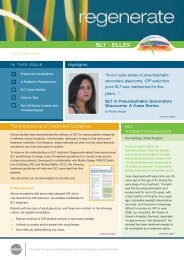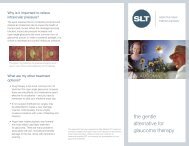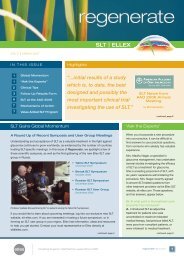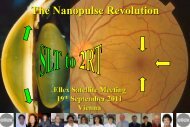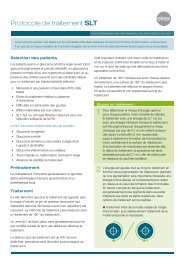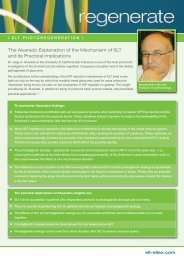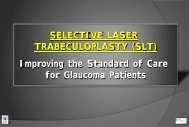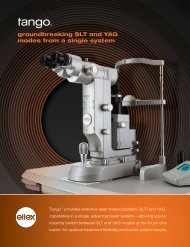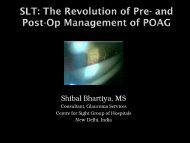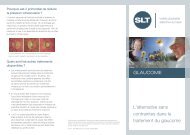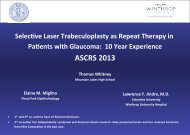SLT Treatment Guidelines - Asia - SLT for Glaucoma | Ellex
SLT Treatment Guidelines - Asia - SLT for Glaucoma | Ellex
SLT Treatment Guidelines - Asia - SLT for Glaucoma | Ellex
Create successful ePaper yourself
Turn your PDF publications into a flip-book with our unique Google optimized e-Paper software.
<strong>SLT</strong> <strong>Treatment</strong> <strong>Guidelines</strong> - <strong>Asia</strong><strong>SLT</strong> PHOTOREGENERATIONThe following treatment guidelines are based on the results of clinical studies and are provided <strong>for</strong> in<strong>for</strong>mationpurposes only. It is the operating ophthalmologists’ responsibility to familiarize themselves with the latestrecommended techniques.Patient SelectionOne of the key elements in achieving good Selective LaserTrabeculoplasty (<strong>SLT</strong>) results is selecting the right patients.Generally, <strong>SLT</strong> is best <strong>for</strong> early to moderate stage glaucomacases where existing patients may be on 1, 2 or 3 glaucomadrops where the intraocular pressure (IOP) is uncontrolled,compliance issues exists, and as a primary treatment <strong>for</strong>newly-diagnosed glaucoma patients. Success rate reduceswhen used on advanced or end-stage glaucoma cases.Patients with most types of glaucoma and those whocon<strong>for</strong>m to the following criteria are suitable candidates:• Require lowering of IOP as either primary orsecondary therapy• Unlikely to comply and/or persist with drug therapy• Have difficulty administering eye drops• Suffer from drug therapy induced side effects• Complain of reduced quality of life due to the needto administer eye drops daily• Failed drug therapy or non-responsive to drug therapy• Pigmentary or pseudoexfoliation glaucoma(Proceed with caution as there is a risk of post-<strong>SLT</strong>IOP spike)• Normal tension glaucoma• Ocular hypertension<strong>SLT</strong> has not been shown to be suitable <strong>for</strong> the followingconditions:• Juvenile or pediatric glaucoma• Primary or secondary angle-closure glaucoma• Inflammatory or uveitic glaucoma• Any disease process or mal<strong>for</strong>mation that blocksthe angle• Unclear view of the trabecular meshwork (TM)Pre-treatmentPre-operative medications typically include an alphaagonist,such as brimonidine tartrate and topical anesthesia,such as proxymetacaine hydrochloride. Also, considerapplying Pilocarpine to tighten the TM or <strong>for</strong> convex irides– this facilitates the treatment.<strong>Treatment</strong>The treatment regime is evolving and protocols varyfrom treatment of 360° and 180° of the TM. It has beenhighlighted that the more aggressive (360°) the treatment,the higher the risk of inducing abnormal pressure spike. Ifa 360° treatment is required, it is recommended that this bedone in two separate 180° sessions.A Latina <strong>SLT</strong> Gonio laser lens (Ocular Instruments, USA)with no image magnification to avoid changes to the spotsize, is used to per<strong>for</strong>m the treatment.The treatment spot size is fixed at 400µm, which is largeenough to irradiate the whole width of the meshwork withsome overspill. This provides a com<strong>for</strong>table margin <strong>for</strong>treatment as the overspill is of no clinical significance.It is important to obtain a clear view of the TM – focus andgood visual clarity must be maintained on the target tissueand do not use the aiming spot to focus.180° treatment involves treatment of a 180° area pertreatment period. <strong>Treatment</strong> is undertaken in single shotmode, placing approximately 50 contiguous but notoverlapping energy spots along the meshwork.<strong>Treatment</strong> Steps:123To determine the optimal level of energy <strong>for</strong> eachpatient, the laser is initially set at 0.6mJ (lower<strong>for</strong> highly-pigmented angles) and the energylevel increased in 0.1mJ steps until the thresholdenergy level <strong>for</strong> small bubble <strong>for</strong>mation (microcavitations) is observed.After the threshold level is found (when smallbubble <strong>for</strong>mation occurs) the energy levelis decreased in 0.1mJ steps as treatmentcontinuous until bubble <strong>for</strong>mation ceases. Thisenergy is then used <strong>for</strong> treatment.After the threshold level is found (when smallbubble <strong>for</strong>mation occurs) the energy level
<strong>SLT</strong> PHOTOREGENERATION<strong>Treatment</strong> Steps continued34is decreased in 0.1mJ steps as treatmentcontinuous until bubble <strong>for</strong>mation ceases. Thisenergy is then used <strong>for</strong> treatment.The process should be monitored and adjustedas neccessary as pigment variation alters energyuptake at a lower threshold. Generally, the TM ismore heavily pigmented inferiorly than superiorly.With this in mind, two options are possible:A Nasal half <strong>for</strong> first 180° treatment (directionis towards the inferior). Enhance treatment willtarget temporal half. Repeat treatment can targeteither half.Post-treatmentNon steroidal anti-inflammatory drops such as Ketorolac orAcular drops four times daily <strong>for</strong> three to five days.Note: An increasing number of physicians are electing notto prescribe post-op medications.Observable Side EffectsThere are minimal observable side effects resulting from<strong>SLT</strong> treatment; these include mild discom<strong>for</strong>t duringthe procedure and tender eyes, perhaps with mildphotophobia, <strong>for</strong> 2-3 days. The absence of adverse sideeffects is one of the major benefits of <strong>SLT</strong> treatment.In a small percentage of cases (



